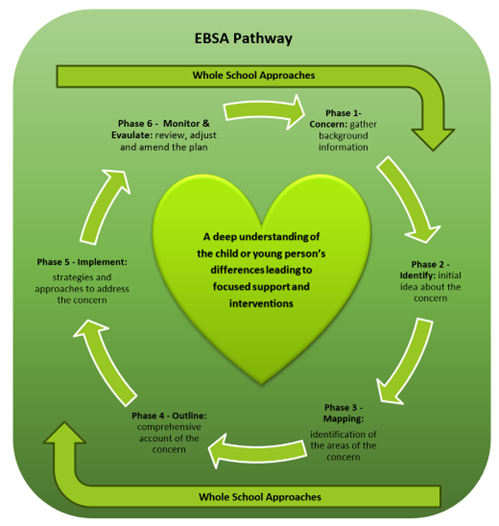Lincolnshire EBSA pathway
When attendance is compromised because of EBSA, or indeed any medical issue, then there is a statutory duty for both school and local authority to deliver education, which can lead to a lack of clarity in relation to roles and responsibilities.
Section 100 of the Children and Families Act, 2014 places a duty on schools to make arrangements for all pupils with medical conditions in terms of both physical and mental health. Whilst section 19 of the Education Act (1996) requires local authority to arrange suitable (so far as health allows) full-time (if suitable) education for children who would otherwise not receive education because of their illness. Caselaw has established that a local authority will have a duty to provide alternative education if there is no suitable education available to the child which is reasonably practicable for the child to access.
The 1996 Education Act (section 7) also places a legal responsibility upon parents or carers to ensure that their child receives an appropriate, full time and effective education (suitable to their educational needs).
In England, the vast majority of parents fulfil their parental responsibility in relation to education by putting their child on a school roll, and ensuring that they attend regularly. However, if a child who is on a school roll and fails to attend regularly then it is possible that the parents will have committed an offence contrary to s444 Education Act 1996, unless one of the four statutory defences apply.
Lincolnshire’s EBSA Pathway clarifies what schools can expect of the local authority and what the local authority must expect from schools in relation to these duties. This, in turn, guides all stakeholders, not least children and families, in understanding what support they should expect to receive, when, where and from whom.
The EBSA Pathway is a graduated response (follows an assess, plan, do, review cycle) that is focused on:
- meaningful and robust early intervention through effective whole school systems.
- clear understanding of individual needs and contexts.
- collaborative, person-centred working with parent and carers and the child or young person.
The pathway considers each stage of EBSA, from indicators of risk of EBSA, through early indicators of EBSA to EBSA occurring, and provides steps to be taken.
The EBSA pathway is a wraparound approach of proactive support. Throughout this is the emphasis on the need for a return to school, alongside support strategies and interventions and adaptations within the school and home environment.
Initial Steps: early intervention and effective whole school systems
School, through their key role in the identification of children and young people who are currently experiencing or are at risk of EBSA, will have effective whole school systems to support young people. This will include being vigilant to early indicators and using a thorough assess, plan, do and review cycle that places children and young person at the heart.
The initial steps within the EBSA pathway support schools to take a preventative measure towards EBSA, with a focus on early intervention and prevention. It is important to identify the early warning signs of EBSA. If unaddressed, the EBSA behaviours can become entrenched making it more difficult to intervene once the child or young person has been out of education for some time.
If a parent or carer has any concerns about early warning signs of possible EBSA then a discussion should take place with the child or young person’s school. This will allow school to explore these worries at the earliest opportunity to ensure the right support is offered that prevents these worries growing.
Early help assessment
These conversations may involve school completing an early help assessment to gain an understanding of the whole picture. This will involve understanding the worries that may be impacting on the child’s well-being and the current strengths that can be built upon to address the worries, as well as who is in the child or young person’s support network and what needs to happen next to support the child.
This will help to determine if the child or young person is displaying EBSA as opposed to truancy or parentally condoned absence so that the appropriate support can be put in place. It will also help determine the next steps, such as a Team Around the Child, to avoid those early warning signs deteriorating into EBSA.
Healthcare plan
Individual healthcare plans can help to ensure that schools effectively support pupils with medical conditions, in terms of both physical and mental health. They provide clarity about what needs to be done, when and by whom. While not all children and young people will require a healthcare plan, they will often be essential, such as in cases where conditions fluctuate or where there is a high risk that emergency intervention will be needed, and are likely to be helpful in the majority of other cases, especially where medical conditions are long-term and complex. The school, healthcare professional and parent should agree, based on evidence, when a healthcare plan would be appropriate.
If a parent or carer has any concerns that a healthcare plan may be needed then a discussion should take place with the child or young person’s school. This will allow school to explore this further and come to an agreement.
Next steps: assess and plan
Assess:
For the majority of children and young people, robust whole school systems and preventative steps through early intervention will ensure needs are met and avoid them developing into EBSA behaviours. For those children and young people that need further support the steps within this Pathway continue the thorough assessment that leads into a robust plan as part of the assess, plan, do and review cycle, with the child or young person at the centre.
For any intervention or support plan to be successful, it is essential to gain an understanding
of the various aspects at the core of the child or young person’s emotional distress and/or social isolation that may be causing and maintaining the EBSA behaviours. It is vital that children and young people’s behaviours are understood in the full complexity of their lives as unique human beings.
It can be tempting to try and identify a simple reason and simple solution for the EBSA behaviour. However, as identified earlier, EBSA is complex and often an interaction of several factors. Therefore, for assessment to be meaningful it will need to be multi-faceted and use a mixture of creative tools for drawing out views. School will lead on this and the gathering of information from the child or young person, their family, key adults in school and involved professionals.
The important element is the quality, depth and richness of the information that is gathered. This allows the areas of concern to be broken down into smaller more manageable parts, identifying how they interact with and contribute to the EBSA behaviours and lead to robust strategies to be implemented. This can be revisited as new information becomes available or the child or young person’s situation changes.
Plan:
Once all the assessment information has been gathered and considered fully, school will draw it together into an EBSA support plan. This is a structured and adaptable plan that involves the child or young person, the family, school and any involved professionals to develop and implement personalised interventions. The plan will address the identified needs of the child or young person both at home and school, ensuring that the strategies effectively target the unique challenges.
The EBSA pathway supports schools to implement a plan that is individualised to the child and linked to the factors that have been identified through assessment as contributing to EBSA. Intervening at both school and home level with a range of strategies.
Further steps: do and review
Do:
Once the initial EBSA support plan is drawn up it will be put into action. This will require ongoing working from everyone involved with the child or young person at the centre to ensure they have ownership of the plan. There may be bumps when carrying out the agreed plan and when this happens there should be a commitment from everyone to find solutions.
The child or young person is likely to be more unsettled at the beginning of the plan and it is key that school and the family need to work together to show a consistent approach to managing heightened emotions and anxieties. The plan should be for a gradual and small step reintegration. Early home visits by a designated member of staff from school, ideally with whom the child or young person has a positive relationship with, will support a sense of connection and ‘school belonging’.
Review:
Once the EBSA support plan is put into action it needs to be continually monitored and adjusted, as needed, through regular planned reviews, consistent communication, realistic goal setting and ongoing collaboration between the child or young person, their family, school and any involved professionals.
It is important to ensure all the agreed resources and support are in place at all times for the child or young person and that there continues to be good communication with the child or young person, family and any involved professionals. Remember to give time for the strategies and approaches to work and achieve the agreed outcomes.
Within the regular reviews the EBSA support plan needs to be updated as part of the ongoing process of evaluating and refining the interventions. This will involve looking at what is working well and any aspects that need changing that build on the positives. Consistency is key. Ensuring that all agreements are consistently followed until the next review and all parties (home, school and professionals) continue to work together with a consistent approach. It is also important to continue to be realistic and break down larger goals into small, achievable steps. High aspirations can be good, but an overly ambitious plan is likely to fail. The plan should continue to aim and plan for a gradual and graded reintegration.
Within the ongoing assess, plan, do and review cycle it will be important to revisit the assessment and planning steps to further develop the Plan as situations develop and change. It is crucial to keep revisiting these at each review to ensure all the planning is focussed on the appropriate and current information.


